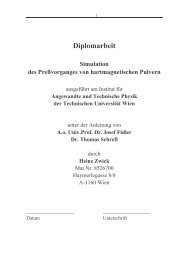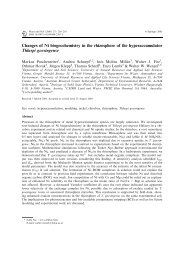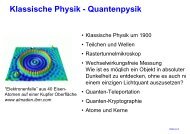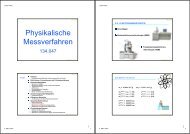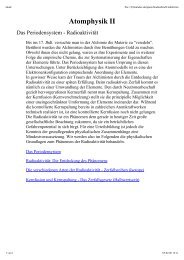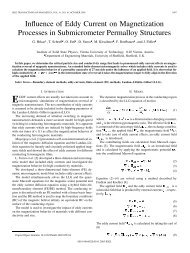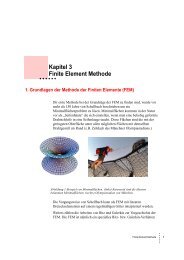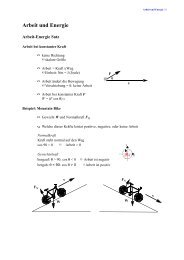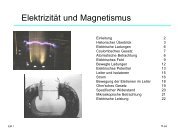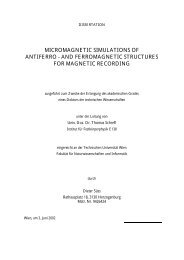Read Back Signals in Magnetic Recording - Research Group Fidler
Read Back Signals in Magnetic Recording - Research Group Fidler
Read Back Signals in Magnetic Recording - Research Group Fidler
You also want an ePaper? Increase the reach of your titles
YUMPU automatically turns print PDFs into web optimized ePapers that Google loves.
FEM Simulations<br />
5.1.4, are used <strong>in</strong> modern sp<strong>in</strong> valves.) The transfer curve and the slope at zero po<strong>in</strong>t do not<br />
differ much compared to the low exchange bias field. However, for large fields we have a<br />
much better sensor performance <strong>in</strong> respect to sensitivity and symmetry. The higher voltage <strong>in</strong><br />
equilibrium is due to the larger angle between both magnetizations. The large exchange bias<br />
field reduces the deflection due to the hard bias, while the free layer magnetization stays<br />
unmodified, because of the widely unchanged demagnetiz<strong>in</strong>g field of the p<strong>in</strong>ned layer.<br />
6.2.3 Influence of Shields<br />
Now the shields are taken <strong>in</strong>to account. It is expected that the shields have an <strong>in</strong>fluence on the<br />
transfer curve due to the mirror currents (see Section 5.1.5). Indeed the shields have a large<br />
<strong>in</strong>fluence. Aga<strong>in</strong> the transfer curve is evaluated by apply<strong>in</strong>g the external field shown <strong>in</strong> Figure<br />
6.5 on the GMR element. The shields are not exposed to the external field. The result is given<br />
<strong>in</strong> Figure 6.7.<br />
Output Voltage [V]<br />
0.109<br />
0.108<br />
0.107<br />
0.106<br />
0.105<br />
0.104<br />
0.103<br />
0.102<br />
-0.10 -0.05 0.00 0.05 0.10<br />
H z [T]<br />
ΔR/R [%]<br />
without shields<br />
with shields<br />
-0.10 -0.05 0.00 0.05 0.10<br />
H z [T]<br />
Figure 6.7: The transfer curves for the sp<strong>in</strong> valve with and without shields (for both<br />
Hexch = 0.1 T).<br />
The presence of shields generally leads to a greater output voltage, particularly at zero field.<br />
The orig<strong>in</strong> of this effect is based on mirror currents. They reduce the current field which<br />
works aga<strong>in</strong>st the demagnetiz<strong>in</strong>g field of the p<strong>in</strong>ned layer. Therefore the demagnetiz<strong>in</strong>g field<br />
2<br />
1<br />
0<br />
-1<br />
-2<br />
-3<br />
-4<br />
-5<br />
72



